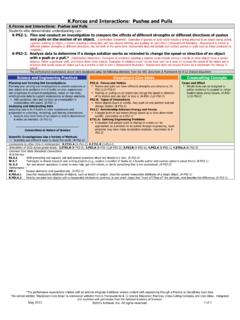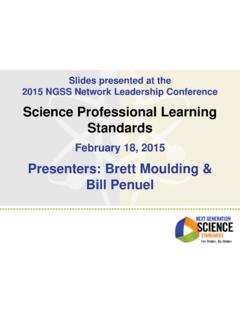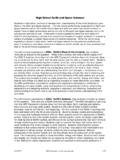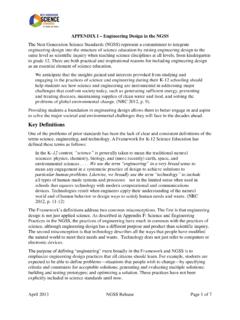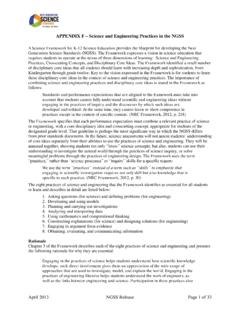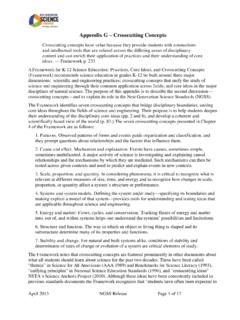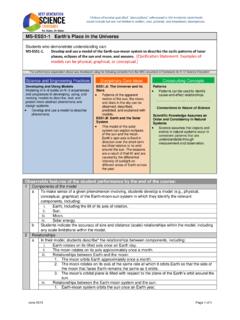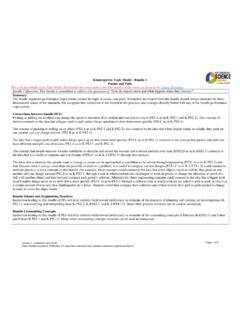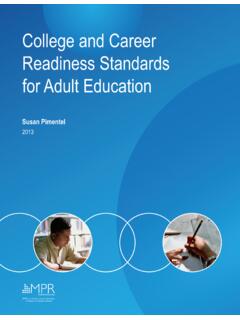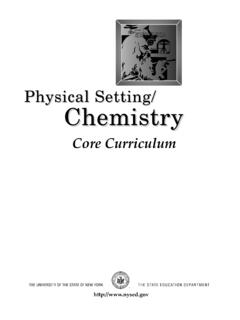Transcription of DCI Arrangements of the Next Generation Science Standards
1 DCI Arrangements of the Next Generation Science Standards Table of Contents Elementary Introduction .. 3. Kindergarten Storyline .. 4. K-PS2 Motion and Stability: Forces and Interactions .. 5. K-PS3 Energy .. 6. K-LS1 From Molecules to Organisms: Structures and Processes .. 7. K-ESS2 Earth's Systems .. 8. K-ESS3 Earth and Human Activity .. 9. First Grade Storyline .. 10. 1-PS4 Waves and their Applications in Technologies for Information 11. 1-LS1 From Molecules to Organisms: Structures and Processes .. 12. 1-LS3 Heredity: Inheritance and Variation of Traits .. 13. 1-ESS1 Earth's Place in the Universe .. 14. Second Grade Storyline .. 15. 2-PS1 Matter and its Interactions .. 16. 2-LS2 Ecosystems: Interactions, Energy, and 17.
2 2-LS4 Biological Evolution: Unity and 18. 2-ESS1 Earth's Place in the Universe .. 19. 2-ESS2 Earth's Systems .. 20. K-2-ETS1 Engineering Design .. 21. Third Grade Storyline .. 22. 3-PS2 Motion and Stability: Forces and Interactions .. 23. 3-LS1 From Molecules to Organisms: Structures and Processes .. 24. 3-LS2 Ecosystems: Interactions, Energy, and 25. 3-LS3 Heredity: Inheritance and Variation of Traits .. 26. 3-LS4 Biological Evolution: Unity and 27. 3-ESS2 Earth's Systems .. 28. 3-ESS3 Earth and Human Activity .. 29. Fourth Grade Storyline .. 30. 4-PS3 31. 4-PS4 Waves and their Applications in Technologies for Information 32. 4-LS1 From Molecules to Organisms: Structures and Processes .. 33. 4-ESS1 Earth's Place in the Universe.
3 34. 4-ESS2 Earth's Systems .. 35. 4-ESS3 Earth and Human Activity .. 36. Fifth Grade Storyline .. 37. 5-PS1 Matter and its Interactions .. 38. 5-PS2 Motion and Stability: Forces and Interactions .. 39. 5-PS3 40. 5-LS1 From Molecules to Organisms: Structures and Processes .. 41. 5-LS2 Ecosystems: Interactions, Energy, and 42. 5-ESS1 Earth's Place in the Universe .. 43. 5-ESS2 Earth's Systems .. 44. 5-ESS3 Earth and Human Activity .. 45. 3-5-ETS1 Engineering Design .. 46. Middle School Physical sciences Storyline .. 47. Middle School Life sciences Storyline .. 49. Middle School Earth and Space sciences Storyline .. 51. Middle School Engineering Design Storyline .. 53. September 2017 2013 Achieve, Inc. All rights reserved.
4 1 of 103. MS-PS1 Matter and Its Interactions .. 54. MS-PS2 Motion and Stability: Forces and Interactions .. 56. MS-PS3 Energy .. 58. MS-PS4 Waves and their Applications in Technologies for Information Transfer .. 60. MS-LS1 From Molecules to Organisms: Structures and Processes .. 61. MS-LS2 Ecosystems: Interactions, Energy, and Dynamics .. 63. MS-LS3 Heredity: Inheritance and Variation of Traits .. 65. MS-LS4 Biological Evolution: Unity and Diversity .. 66. MS-ESS1 Earth's Place in the Universe .. 68. MS-ESS2 Earth's Systems .. 70. MS-ESS3 Earth and Human Activity .. 72. MS-ETS1 Engineering Design .. 74. High School Physical sciences Storyline .. 75. High School Life sciences Storyline .. 77. High School Earth and Space sciences Storyline.
5 79. High School Engineering Design 81. HS-PS1 Matter and Its Interactions .. 82. HS-PS2 Motion and Stability: Forces and Interactions .. 84. HS-PS3 Energy .. 86. HS-PS4 Waves and their Applications in Technologies for Information Transfer .. 88. HS-LS1 From Molecules to Organisms: Structures and 90. HS-LS2 Ecosystems: Interactions, Energy, and Dynamics .. 92. HS-LS3 Heredity: Inheritance and Variation of Traits .. 94. HS-LS4 Biological Evolution: Unity and Diversity .. 95. HS-ESS1 Earth's Place in the Universe .. 97. HS-ESS2 Earth's Systems .. 99. HS-ESS3 Earth and Human Activity ..101. HS-ETS1 Engineering September 2017 2013 Achieve, Inc. All rights reserved. 2 of 103. Elementary Standards Students in kindergarten through fifth grade begin to develop an understanding of the four disciplinary core ideas: physical sciences ; life sciences ; earth and space sciences ; and engineering, technology, and applications of Science .
6 In the earlier grades, students begin by recognizing patterns and formulating answers to questions about the world around them. By the end of fifth grade, students are able to demonstrate grade-appropriate proficiency in gathering, describing, and using information about the natural and designed world(s). The performance expectations in elementary school grade bands develop ideas and skills that will allow students to explain more complex phenomena in the four disciplines as they progress to middle school and high school. While the performance expectations shown in kindergarten through fifth grade couple particular practices with specific disciplinary core ideas, instructional decisions should include use of many practices that lead to the performance expectations.
7 September 2017 2013 Achieve, Inc. All rights reserved. 3 of 103. Kindergarten The performance expectations in kindergarten help students formulate answers to questions such as: What happens if you push or pull an object harder? Where do animals live and why do they live there? What is the weather like today and how is it different from yesterday? . Kindergarten performance expectations include PS2, PS3, LS1, ESS2, ESS3, and ETS1. Disciplinary core Ideas from the NRC Framework. Students are expected to develop understanding of patterns and variations in local weather and the purpose of weather forecasting to prepare for, and respond to, severe weather. Students are able to apply an understanding of the effects of different strengths or different directions of pushes and pulls on the motion of an object to analyze a design solution.
8 Students are also expected to develop understanding of what plants and animals (including humans) need to survive and the relationship between their needs and where they live. The crosscutting concepts of patterns;. cause and effect; systems and system models; interdependence of Science , engineering, and technology; and influence of engineering, technology, and Science on society and the natural world are called out as organizing concepts for these disciplinary core ideas. In the kindergarten performance expectations, students are expected to demonstrate grade-appropriate proficiency in asking questions, developing and using models, planning and carrying out investigations, analyzing and interpreting data, designing solutions, engaging in argument from evidence, and obtaining, evaluating, and communicating information.
9 Students are expected to use these practices to demonstrate understanding of the core ideas. September 2017 2013 Achieve, Inc. All rights reserved. 4 of 103. K-PS2 Motion and Stability: Forces and Interactions K-PS2 Motion and Stability: Forces and interactions Students who demonstrate understanding can: K-PS2-1. Plan and conduct an investigation to compare the effects of different strengths or different directions of pushes and pulls on the motion of an object. [Clarification Statement: Examples of pushes or pulls could include a string attached to an object being pulled, a person pushing an object, a person stopping a rolling ball, and two objects colliding and pushing on each other.] [Assessment Boundary: Assessment is limited to different relative strengths or different directions, but not both at the same time.]
10 Assessment does not include non-contact pushes or pulls such as those produced by magnets.]. K-PS2-2. Analyze data to determine if a design solution works as intended to change the speed or direction of an object with a push or a pull.* [Clarification Statement: Examples of problems requiring a solution could include having a marble or other object move a certain distance, follow a particular path, and knock down other objects. Examples of solutions could include tools such as a ramp to increase the speed of the object and a structure that would cause an object such as a marble or ball to turn.] [Assessment Boundary: Assessment does not include friction as a mechanism for change in speed.]. The performance expectations above were developed using the following elements from the NRC document A Framework for K-12 Science Education: Science and Engineering Practices Disciplinary core Ideas Crosscutting Concepts Planning and Carrying Out Investigations : Forces and Motion Cause and Effect Planning and carrying out investigations to answer questions or Pushes and pulls can have different strengths and directions.
